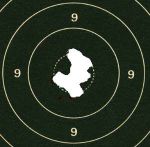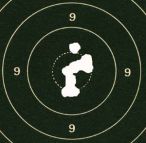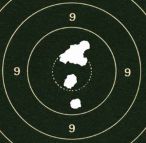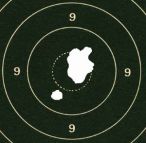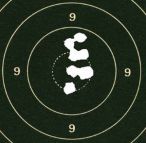Testing Steyr LP10E Air Pistol at 20 Yards
Following on from our earlier forays into more serious bench testing, we decided that having evaluated the relative grouping possibilities of several grades of pellets with different resultant
muzzle velocities at 20 yards, that on this occasion we would try to determine the relevant group size and position on the target at 20 yards when slight variations were made to the average muzzle
velocity.
As on previous test sessions, a Combo chronoscope was fitted to the muzzle of the slightly modified LP10E and carefully aligned to prevent erroneous readings. The Steyr Sportwaffen LP10E had
previously been set up to operate at a much higher muzzle velocity as part of the research into the feasibility of the achievable performance at longer distances.
The air cylinder for the pistol was pre-charged to 200 bar before the first tests were carried out. As only a total of approximately 100 shots were going to be fired, there is no reason to doubt the
consistency of the air supply to the pistol.
The now proven and trusted pistol bench test rig was set up at 20 yards from the target and a few test elevation shots fired. It soon became apparent that despite an amount of fine adjustment, it
would not be practical to locate the resultant shot holes near to the centre of the target. It was decided to fire the test shots at the reverse side of a target and then to later superimpose the
results over an image of a PL15 target.
The pellets used were H & N Finale Match Rifle 4.49mm. These were chosen for their slight increase in weight, which it was hoped would help to create a slightly more stable flight trajectory.
Several different grades of pellets had been earlier tested to try to determine the most consistent muzzle velocities, as part of the ongoing investigations for suitable pellets for 50 metre
shooting. That could be the subject of another test report in the future.
After a few stabilisation shots to ensure that the pre-charged air cylinder was temperature stabilised at the ambient temperature of 16ºC and relative humidity of 58% the test were started.
A series of 10 shots were fired, the average muzzle velocity calculated and the resultant shot pattern card annotated. The muzzle velocity was then adjusted and some stabilisation shots fired before
commencing the next test series of 10 shots. This procedure was followed for each subsequent change in muzzle velocity.
Having started at the current average operation velocity of 553FPS, the velocity was gradually turned down, eventually stopping at an average of 513FPS as it was felt that the group image was
starting to spread. The average velocity was then turned back to possibly the best value of 526FPS.
It was decided not to increase the muzzle velocity above 553FPS average, as it was felt that little would be gained if the velocity becomes too high and started to introduce possible "muzzle
flip".
As can be seen from the resultant groups, there is very little to choose between them as they are all good, with most of the shots within the ‘10’ ring. The other observation was that despite the
changes in the average muzzle velocity, there was only a slight variation in the vertical position of the shots and group on the target.
These tests provided some further details in the form of slightly less consistency of muzzle velocity when compared to the previous tests and subsequently some spurious group patterns, this may be a
feature of this particular pistol; however, we feel that this probably did not detract from the overall results.
The conclusions drawn from these tests are that the previously found most consistent average muzzle velocity of 526FPS also produces the best relevant group on the target. It should be noted that the
pistol used for these tests is different from the one that was used for the 10 metre tests, as the two pistols have been deliberately set up and are used at one distance only.
Having gained this information which once again reinforces the established thoughts that the LP10E barrel performs best at around 525FPS, it now remains to put the knowledge into practice by trying
to achieve similar results when shooting at match targets.
In order to clarify the results and give a representative indication of the details that have been obtained, it should be noted that the diameter of the 10 ring is 33mm and the diameter of the 10X or
carton ring is 15mm.
Very good shooting scores at are attainable 20 yards using air pistols, so provided you can set the targets up safely, why not give it a try.
At present, the scores that can be achieved at 20yards with an air pistol, are probably slightly better than could have been obtained with a single shot .22 rimfire pistol, due to the lack of
recoil.
There is probably a 25 yard .22 rifle range/club somewhere near you that you may be able to book range space on. You will not be disappointed.
DO NOT attempt 20yard shooting in your "back garden", stray pellets could cause a major safety hazard to others.
If pellets leave the confines of your property, you are breaking the UK Firearms Law, which could result in considerable Police interest.
All images have been created by superimposing the image of the shot holes over the image of a PL15 20 yard target. There have been no modifications to the images only enlargement for clarity.
For further information, you can contact us at coaching@tenrings.co.uk
All images are the copyright © of Tenrings Coaching and www.tenrings.co.uk unless otherwise stated.




